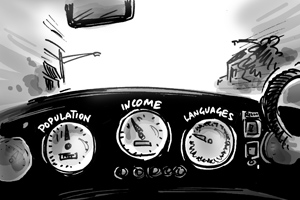.id is proud to announce the launch of our National Demographic Indicators Series (NDIS).
These are ranking tables for all Local Government Areas (LGAs) on a range of demographic measures. We have put these online as a public resource, for all interested individuals and organisations.
These indicators can answer all sorts of interesting questions such as:
Which area has the highest incomes in Australia?
Where is the highest proportion of over 65s?
Which LGA has the largest households in Australia?
What is the most diverse area, for people speaking a language other than English at home?
Read on for the answers….


Access the National Demographic Indicators Series here.
The main reasons for putting together a set of National Demographic Indicators is:
- Many of our clients want to compare with areas and see where they rank, even against LGAs who are not .id clients.
- The ABS has moved away from using Local Government as a standard output unit, but most people relate to LGAs as areas of interest far more than SA2s or SA3s.
- It’s a lot of fun!
The indicators we’ve included are sourced from the 2011 Census of Population and Housing, except for Estimated Resident Population, which is updated annually. They are broken into 3 main categories as follows:
- Population (Estimated Resident Population, aged under 5, aged over 65, Median age, Speaks a language other than English, Indigenous population, and people who changed address over 5 years).
- Work & Education (Public transport to work, Attending university, University qualifications) – note that more work related indicators are included in our National Economic Indicators Series
- Households and Dwellings (Median income, Average Household Size, Households Renting, Medium and High density housing stock)
- Disadvantage (SEIFA index)
The indicators are arranged by state – so pick your state, and you can rank ascending or descending within your state on each indicator. The numbers on the left show you where your area ranks among all LGAs within the state. To do a national ranking you need to go through each state. Data notes explain the relevance of each indicator, and there is a little orange arrow at the end of each row, which takes you to more extensive .id’s demographic and economic information tools for that area if they are a subscriber.
So, enjoy exploring the rankings on each of the demographic indicators. And the answers to those questions at the top?
Which area has the highest incomes in Australia? (Roebourne Shire, WA, $2,839 per week)
Where is the highest proportion of over 65s? (Victor Harbor District Council, SA – 34.8%)
Which LGA has the largest households in Australia? (East Arnhem Council, NT, 7.06 people per household)
What is the most diverse area, for people speaking a language other than English at home? (Auburn City, NSW, 71.0%)
In future blogs, we’ll explore some of the more interesting rankings, and look at why these areas rank very high or low on particular indicators.
Access the National Demographic Indicators Series (NDIS) here, and the National Economic Indicators Series (NEIS) here and see how your area rank within Australia.






.png)
.jpg)





